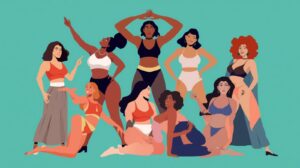The definition of beauty has always been a moving target, influenced by cultural shifts, social media trends, and economic factors. As we dive into the 21st century, the need to challenge modern beauty standards becomes increasingly evident. These standards, which often set unrealistic expectations, have profound effects on individual self-esteem and societal well-being. In this article, we will explore the origins of these standards, their impact on society, and the growing movement to redefine beauty in more inclusive and authentic terms.
The Evolution of Beauty Standards
To understand current beauty standards, it’s essential to look at their historical context. Beauty ideals have shifted dramatically over the decades, influenced by cultural icons, technological advances, and changing social norms. From the voluptuous figures celebrated in Renaissance art to the waif-like models of the 1990s, each era reflects a distinct set of values.
The Global Influence of Chinese Beauty Standards
In recent years, Chinese beauty standards have gained global attention. The emphasis on fair skin, slender figures, and delicate features reflects a complex interplay of cultural heritage and modern influences. These standards are not only prevalent in China but are also impacting beauty trends worldwide, thanks to the rise of K-beauty and J-beauty in the global market.
The Impact of Beauty Trends on Society
Beauty trends shape not only individual perceptions but also societal norms. The pressure to conform to these ideals can lead to various psychological and physical health issues, including body dysmorphia, eating disorders, and reduced self-esteem.
The Role of Social Media
Social media platforms have become powerful tools for perpetuating and challenging beauty standards. While they often amplify unrealistic ideals, they also offer a space for diverse voices to promote body positivity and inclusivity. Influencers and activists are using these platforms to challenge conventional beauty norms, encouraging followers to embrace their unique features.
The Economic Implications
The beauty industry is a multi-billion dollar sector that thrives on the perpetuation of specific beauty ideals. Companies invest heavily in marketing campaigns that reinforce these standards, driving consumer behavior. However, there is a growing demand for products that celebrate diversity and cater to a broader range of beauty needs.

Redefining Beauty: A Movement Toward Inclusivity
The movement to redefine beauty is gaining momentum, with individuals and organizations advocating for more inclusive and authentic representations. This shift is not just about changing beauty norms but also about fostering a culture that values diversity and self-expression.
Embracing Authenticity and Diversity
The call for authenticity and diversity in beauty standards is resonating across the globe. Campaigns like Dove’s Real Beauty and Fenty Beauty’s inclusive product lines are setting new industry standards by celebrating different skin tones, body types, and gender expressions.
The Role of Wellness in Beauty
Wellness trends are increasingly intersecting with beauty standards, promoting a holistic approach to self-care that prioritizes mental and physical health over appearance. This paradigm shift encourages individuals to focus on how they feel rather than how they look, fostering a more balanced view of beauty.
Practical Steps for Industry Professionals
For wellness product developers, lifestyle magazine editors, and health and wellness coaches, understanding these dynamics is crucial. Here are some actionable strategies:
For Wellness Product Developers
- Innovate with Inclusivity: Design products that cater to a diverse consumer base, considering various skin tones, hair types, and personal preferences.
- Leverage Consumer Feedback: Engage with consumers to understand their needs and preferences, using this feedback to guide product development.
For Lifestyle Magazine Editors
- Highlight Diverse Narratives: Feature stories that reflect a wide range of beauty experiences, challenging traditional norms and celebrating individuality.
- Collaborate with Influencers: Partner with influencers who advocate for body positivity and inclusivity to reach a broader audience.
For Health and Wellness Coaches
- Educate Clients: Help clients understand the impact of societal beauty standards and encourage them to define beauty on their own terms.
- Promote Self-Compassion: Foster a mindset of self-compassion and acceptance, guiding clients towards a healthier relationship with their bodies.
Conclusion
Challenging modern beauty standards is not just a trend; it’s a necessary evolution towards a more inclusive and authentic society. By embracing diversity, promoting wellness, and redefining beauty, we can create a culture that celebrates individuality and fosters genuine self-expression. As industry professionals, the opportunity to drive this change is in your hands. Embrace it, and help shape the future of beauty for generations to come.




